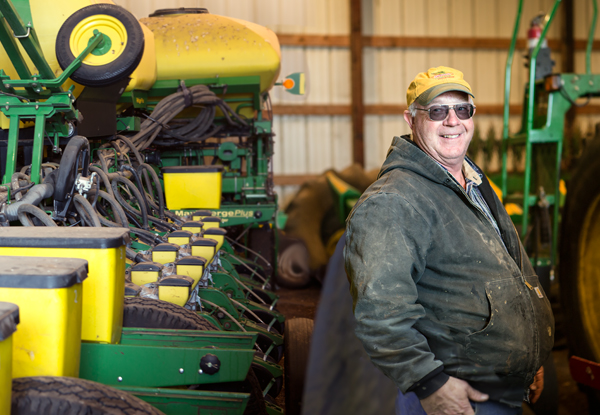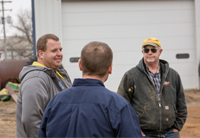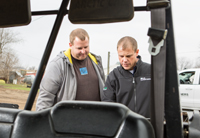
An Iowa farm family wanted more. They wanted to change their growth from stagnant to striving. The farm could not yield above 220-bushel corn and could not touch yield over 65-bushel beans. To reach the yield of their dreams, the Mart family in northwestern Iowa decided to go beyond conventional thinking. Instead of traditional fields of corn and beans, they switched it up, planting corn and beans in strips. Six rows of corn, then six rows of beans. Across the entire field.
WHY THEY’RE DOING IT
The Mart family, Mike and his two sons, went to a Hefty Seed Company agronomy event in Mankato, Minnesota, five years ago. There were at least 600 farmers there. During the event, the Marts caught wind of one grower in northern Iowa who was just adventurous enough to do six rows of corn next to six rows of beans with very good success. Inspired by what they learned, Mike and his son Greg came to the conclusion that it just might increase their efficiency, too.
The original farmer who incorporated this practice proved what most farmers see every year – that corn on the edge of the fields delivers higher yields because it receives more direct sunlight. The intent is to create an entire field of end rows to maximize sunlight exposure.
“Sunlight is very abundant and free, so why not try to capture more of it?” asks Mike Mart, paternal owner of the farm. “It is the cheapest way to grow more bushels on the same amount of land.” Utilizing this interesting technique allows the plant to capture sunlight on the whole plant, which also helps keep the plant healthier.
“Everyone is spending so much money on the same thing or trying new things to capture a few bushels at most, and not seeing the results,” Mike says. “People were spending eight dollars per acre on a product or input and only getting nine dollars and fifty cents back. It didn’t add up to very high return on investments. We wanted to grow more bushels without spending a ton of money on equipment or expensive, ineffective products. The little farmers can produce more per acre without having to farm a lot more ground with this plan.”
HOW IT WORKS

With the goal of each plant receiving as much sunlight as possible, planting, spacing and increasing population became very important. The Mart family consulted with Aaron Kaiser, a sales agronomist with Ag Partners, to discuss their plans and the best approach for implementation.
“When they first told me, I thought, ‘That’s different,'” muses Kaiser. “I wanted to see it.”
The first year, the Marts planted a small portion of their farm, 600 acres of the corn/beans row alternation, with around 10 different hybrids. They worked with Kaiser to determine the best hybrid varieties and location to optimize the characteristics.
Equipment was a big part of the equation, so the Marts were conscientious about how expensive changes could be and aimed to make modifications as inexpensive as possible. The biggest changes were going to have to be how the planter worked and how the beans would be harvested. They got the planter first – a 2001, 12-row John Deere finger pickup planter, and modified it to plant six rows of corn and six rows of beans at the same time. Sprockets were changed to achieve higher populations on the two outside corn rows closest to the beans. They modified the rows next to them to decrease the population. The innermost corn rows have a more “normal” or typical population. Soybeans are planted more traditionally, in narrow, 15-inch consistent rows. According to the Mart family, once the equipment and placement are figured out, the 15-foot strip technique is easy and can be done in a timely manner.
The Marts quickly realized some hybrids respond with drastically more yield as a result of more sunlight. The opposite was found with certain soybean hybrids, where some had less of a yield drop due to increased shade from the corn than others.
“Proper hybrid selection is key to being economical,” Greg says. “There are no yield results or existing test results that can be used based on sunlight, so our selection mainly has to be trial and error.”
Of course, there is more to farming than just planting and harvesting. Before planting, the Marts conventionally till the field. They live in an area of Iowa where they say “no till means reduced yield.” Then, their applications are done broadband, with herbicide that is applicable to both corn and beans.
Once tilling and application are done, the complex planting comes in, which includes fertilizer application. The Marts’ fertilizer program has also been consistent, by utilizing MicroEssentials® by The Mosaic Company over the years.
Finally, harvesting the crops, starting with soybeans, finishes the season. Beans are always on the ends, so the Mart trio can get into the center to harvest corn. They come back later and take out corn.
HOW IT HAS EVOLVED (BECAUSE THEY ARE INNOVATIVE GROWERS AFTER ALL)

“There’s always something you can change, and we’re always working on it,” Mike says.
In addition to attending meetings regularly that give them new and innovative ideas for arranging their field, these guys have visited with every competitive grower winner they can. They do their fair share of research. They know that even competitive growers who have won world records do not always have high average yields, just one high-yielding plot. The Mart family learns as much as they can from yield winners.
“The Marts are some of the most soil-literate farmers out here,” states Kaiser. “It’s fun to work with growers like this who have a good understanding of soils and fertility and aren’t afraid of trying something completely outside the box.”
From the first year to the second year, there have been many changes to the process. The Marts made the soybean rows narrower. They also changed up their planter, realizing speed and accuracy are both critical when trying to get seed in the ground at exactly the right distance apart with the correct variety, so they worked on converting their 24-row planter to be able to plant in strips as well.
Next year, they plan to plant more than 1,600 acres with more than 30 different hybrids.
BENEFITS OF INNOVATION
This is the fourth year Mike Mart and his sons have planted 15-foot strips of corn and beans, and there is a reason why they are expanding the amount of acres in which they apply this technique. They have seen over a 60-bushel increase in corn and only a 5-bushel decrease as a result of less sunlight in soybeans. The soybean yield reduction depends on variety, as they have seen some of their highest yields come out of the strips. The yield averages are considered unbelievable by many neighbors – even insurance adjusters.
“We tell them to come ride in the combine or walk out and look in the fields,” Mike says.
The last year they applied this technique, everyone else’s corn died three weeks earlier than the Mart family’s corn. Their fields were still green and getting more grain fill.
“They went ahead and did it instead of just talking about it,” Kaiser says. “They didn’t care what anybody else did or said.”
They’ve also said not everything regarding this practice is all about the benefits. It does take more trucks and trips to haul all the corn away.